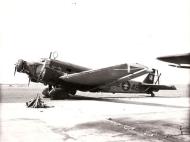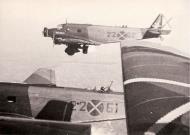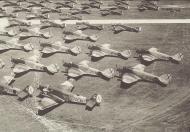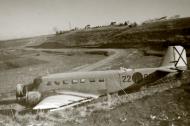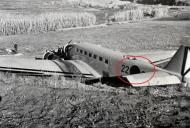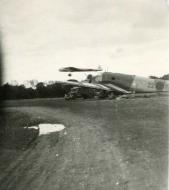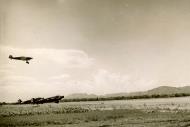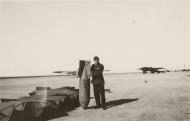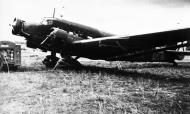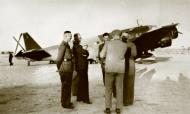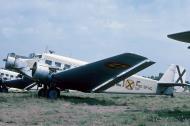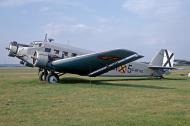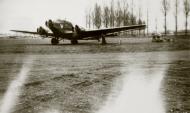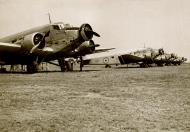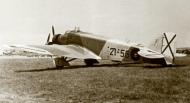Nationalist AF Junkers Ju 52 photo gallery
Heinkel He 45 Nationalist AF La Senia Catalonia Spain 1939 ebay 01
Junkers Ju 52 3mg3e(W) Nationalist AF Legion Condor seaplane 527 web 01
Junkers Ju 52 3mg3e Grupo de Bombardeo Nocturno 2248 2G22 Jan 1937 0A
Junkers Ju 52 3mg3e Grupo de Bombardeo Nocturno 2262 2E22 Jan 1937 0A
Junkers Ju 52 3mg3e Nationalist AF 1/K88 Legion Condor 2280 force landed Spain ebay 01
Junkers Ju 52 3mg3e Nationalist AF 1/K88 Legion Condor 2286 force landed Jan 1937 ebay 01
Junkers Ju 52 3mg3e Nationalist AF 1/K88 Legion Condor 2288 Spain Jan 1937 ebay 01
Junkers Ju 52 3mg3e Nationalist AF 1/K88 Legion Condor 2290 Jan 1937 0A
Junkers Ju 52 3mg3e Nationalist AF at their dispersal area Spain 1939 ebay 01
Junkers Ju 52 3mg3e Nationalist AF foreground Spain 1939 ebay 01
Junkers Ju 52 3mg3e Republican Spanish AF 1a Escuadrilla 0A
Junkers Ju 52 3mg5e SNAA 22x101 Salamanca 1937 01
Savoia Marchetti SM.81 16 Group 21x58 Spain very similar in design to the Ju 52 wiki 01
Ju-52-3m SNAA (22x101) Salamanca 1937
Photo 01: Extensively used during the Civil War, almost all Junkers Ju-52’s left KG/88 in the spring of 1937 to be transferred to the Spanish Nationalist Air Arm. As there is no way of distinguishing between German or Spanish-operated aircraft it is impossible to determine the nationality of the crew. Photograph at Salamanca this Junkers Ju-52/3m, coded 22x101, wore all the usual markings seen on the type; a large white underwing cross quite separate from the black disc, and no disc on the upper surfaces of the wings. The camouflage was 61/62/63/65 and the photograph was taken at Salamanca.
Junkers Ju 52 Trimotor transport aircraft
- Role: Transport aircraft
- Manufacturer: Junkers
- Designer: Ernst Zindel
- First flight: 13 October 1930 (Ju 52/1m); 7 March 1932 (Ju 52/3m)
- Primary user: Luftwaffe
- Produced: 1931–1945 (Germany), 1945–1947 (France), 1945–1952 (Spain)
- Number built: 4,845
The Junkers Ju 52 (nicknamed Tante Ju ('Auntie Ju') and Iron Annie) was a German trimotor transport aircraft manufactured from 1932 to 1945. It saw both civilian and military service during the 1930s and 1940s. In a civilian role, it flew with over 12 air carriers including Swissair and Deutsche Luft Hansa as an airliner and freight hauler. In a military role, it flew with the Luftwaffe as a troop and cargo transport and briefly as a medium bomber. The Ju 52 continued in postwar service with military and civilian air fleets well into the 1980s.
Operational history
Spanish Civil War chronology: The War
1936
In the early days of the war, over 50,000 people who were caught on the wrong side of the lines were assassinated or executed. In these paseos ( strolls ), as the executions were called, the victims were taken from their refuges or jails by armed people to be shot outside of town. The corpses were abandoned or interred in graves dug by the victims themselves. Local police just noted the appearance of the corpses. Probably the most famous such victim was the poet and dramatist Federico Garcia Lorca. The outbreak of the war provided an excuse for settling accounts and resolving long-standing feuds. Thus, this practice became widespread during the war in conquered areas.
Any hope of a quick ending to the war was dashed on 21 July, the fifth day of the rebellion, when the Nationalists captured the main Spanish naval base at Ferrol in northwestern Spain. This encouraged the Fascist nations of Europe to help Franco, who had already contacted the governments of Nazi Germany and Fascist Italy the day before. On July 26, the future Axis Powers cast their lot with the Nationalists. A rebel force under Colonel Beorlegui Canet, sent by General Emilio Mola, advanced on Guipuzcoa. On September 5th, after heavy fighting it took Irun closing the French border to the Republicans. On September 13th the Basques surrendered San Sebastian to the Nationalists who then advanced toward their capital, Bilbao but were halted by the Republican militias on the border of Viscaya at the end of September. The capture of Guipuzcoa had isolated the Republican provinces in the north.
To the south, Nationalist forces under Franco won another victory on 27 September when they relieved the Alcazar at Toledo. A Nationalist garrison under Colonel Moscardo had held the Alcazar in the center of the city since the beginning of the rebellion, resisting for months against thousands of Republican troops who completely surrounded the isolated building. The inability to take the Alcazar was a serious blow to the prestige of the Republic, as it was considered inexplicable in view of their overwhelming numerical superiority in the area. Two days after relieving the siege, Franco proclaimed himself Generalisimo and Caudillo ( chieftain ) while forcibly unifying the various and diverse Falangist, Royalist and other elements within the Nationalist cause.
In October, the Francoist troops launched a major offensive toward Madrid, reaching it in early November and launching a major assault on the city on 8 November. The Republican government was forced to shift from Madrid to Valencia, out of the combat zone, on 6 November. However, the Nationalists attack on the capital was repulsed in fierce fighting between November 8 and 23. A contributory factor in the successful Republican defense was the arrival of the International Brigades, though only around 3000 of them participated in the battle. Having failed to take the capital, Franco bombarded it from the air and, in the following two years, mounted several offensives to try to encircle Madrid. (See also Siege of Madrid (1936-39))
On 18 November, Germany and Italy officially recognized the Franco regime, and on 23 December, Italy sent volunteers of its own to fight for the Nationalists.
1937
With his ranks being swelled by Italian troops and Spanish colonial soldiers from Morocco, Franco made another attempt to capture Madrid in January and February 1937, but failed again.
On 21 February the League of Nations Non-Intervention Committee ban on foreign national volunteers went into effect. The large city of Malaga was taken on 8 February. On 7 March German Condor Legion equipped with Heinkel He 51 biplanes arrived in Spain; on 26 April the Legion was responsible for the infamous massacre of hundreds, including numerous women and children, at Guernica in the Basque Country; the event was committed to notoriety by Picasso. Two days later, Francos army overran the town.
After the fall of Guernica, the Republican government began to fight back with increasing effectiveness. In July, they made a move to recapture Segovia, forcing Franco to pull troops away from the Madrid front to halt their advance. Mola, Francos second-in-command, was killed on June 3, and in early July, despite the fall of Bilbao in June, the government actually launched a strong counter-offensive in the Madrid area, which the Nationalists repulsed with some difficulty. The clash was called Battle of Brunete (Brunete is a town in the province of Madrid).
After that, Franco regained the initiative, invading Aragon in August and then taking the city of Santander. With the surrender of the Republican army in the Basque territory and after two months of bitter fighting in Asturias (Gijon finally fell in late October) the war was effectively ended in the north front with a Francoist victory.
Meanwhile, on August 28, the Vatican recognized Franco, and at the end of November, with Francos troops closing in on Valencia, the government had to move again, this time to Barcelona.
1938
The Battle of Teruel was an important confrontation between Nationalist and Republican troops. The city belonged to the Nationalists at the beginning of the battle, but remarkably, the Republicans conquered it in January. The Francoist troops launched an offensive and recovered the city by 22 February. However, in order to do so, Franco had to rely heavily on German and Italian air support and subsequently repaid them with extensive mining rights. On March 7, the Nationalists launched the Aragon Offensive. By April 14, they had pushed through to the Mediterranean Sea, cutting the Republican government-held portion of Spain in two. The Republican government tried to sue for peace in May but Franco demanded unconditional surrender, and the war raged on. The Nationalist army pressed southward from Teruel and along the coast toward the capital of the Republic at Valencia but was halted in heavy fighting along the fortified XYZ Line.
The Republican government then launched an all-out campaign to reconnect their territory in the Battle of the Ebro, beginning on July 24 and lasting until November 26. The campaign was militarily unsuccessful, and was undermined by the Franco-British appeasement of Hitler in Munich with the concession of Czechoslovakia. This effectively destroyed the last vestiges of Republican morale by ending all hope of an anti-fascist alliance with the Western powers. The retreat from the Ebro all but determined the final outcome of the war. Eight days before the new year, Franco struck back by throwing massive forces into an invasion of Catalonia.
1939
Francos troops conquered Catalonia in a whirlwind campaign during the first two months of 1939. Tarragona fell on 14 January, followed by Barcelona on 26 January and Girona on 5 February. Five days after the fall of Girona, the last resistance in Catalonia was broken.
On 27 February, the governments of the United Kingdom and France recognized the Franco regime.
Only Madrid and a few other strongholds remained for the Republican government forces. Then, on 28 March, with the help of pro-Franco forces inside the city (not as effective as described by General Mola in his propagandistic broadcasts of 1936 referring to the so-called fifth column ), Madrid fell to the Nationalists. The next day, Valencia, which had held out under their guns for close to two years, also surrendered. Franco proclaimed victory in a radio speech aired on 1 April, when the last of the Republican forces surrendered.
After the end of the War, there were harsh reprisals against Francos former enemies, when thousands of Republicans were imprisoned and at least 30,000 executed. Others have calculated these deaths at from 50,000 to 200,000. Many others were put to forced labour, building railways, drying out swamps, digging canals (La Corchuela, the Canal of the Bajo Guadalquivir), construction of the Valle de los Caidos monument, etc. Hundreds of thousands of other Republicans fled abroad, especially to France and Mexico. Some 500,000 of them fled to France.
On the other side of the Pyrenees, refugees were confined in internment camps of the French Third Republic, such as Camp Gurs or Camp Vernet, where 12,000 Republicans were housed in squalid conditions (mostly soldiers from the Durruti Division). The 17,000 refugees housed in Gurs were divided into four categories (Brigadists, pilots, Gudaris and ordinary Spaniards). The Gudaris (Basques) and the pilots easily found local backers and jobs, and were allowed to quit the camp, but the farmers and ordinary people, who could not find relations in France, were encouraged by the Third Republic, in agreement with the Francoist government, to return to Spain. The great majority did so and were turned over to the Francoist authorities in Irun. From there they were transferred to the Miranda de Ebro camp for purification according to the Law of Political Responsibilities.
After the proclamation by Marshall Petain of the Vichy regime, the refugees became political prisoners, and the French police attempted to round-up those who had been liberated from the camp. Along with other undesirables, they were sent to the Drancy internment camp before being deported to Nazi Germany. About 5,000 Spaniards thus died in Mauthausen concentration camp. The Chilean poet Pablo Neruda, who had been named by the Chilean President Pedro Aguirre Cerda special consul for immigration in Paris, was given responsibility for what he called the noblest mission I have ever undertaken : shipping more than 2,000 Spanish refugees, who had been housed by the French in squalid camps, to Chile on an old cargo ship, the Winnipeg.
After the official end of the war, guerrilla war was waged on an irregular basis, well into the 1950s, being gradually reduced by the scant support from an exhausted population and military defeats. In 1944, a group of republican veterans, who also fought in the French resistance against the Nazis, invaded the Val dAran in northwest Catalonia, but they were defeated after 10 days.
Social revolution
In the anarchist-controlled areas, Aragon and Catalonia, in addition to the temporary military success, there was a vast social revolution in which the workers and peasants collectivised land and industry, and set up councils parallel to the paralyzed Republican government. This revolution was opposed by both the Soviet-supported communists, who ultimately took their orders from Stalins politburo (which feared a loss of control), and the Social Democratic Republicans (who worried about the loss of civil property rights). The agrarian collectives had considerable success despite opposition and lack of resources, as Franco had already captured lands with some of the richest natural resources.
As the war progressed, the government and the communists were able to leverage their access to Soviet arms to restore government control over the war effort, through both diplomacy and force. Anarchists and the Workers Party of Marxist Unification (Partido Obrero de Unificacion Marxista, or POUM) were integrated with the regular army, albeit with resistance; the POUM was outlawed and falsely denounced as an instrument of the fascists. In the May Days of 1937, many hundreds or thousands of anti-fascist soldiers fought one another for control of strategic points in Barcelona, recounted by George Orwell in Homage to Catalonia.
Junkers Production Lists
Junkers Ju52
Ju52 ATG lines 1xxx and 2xxx/3xxx Ju52 Junkers lines 4xxx to 7xxxx Ju52 batches 130xxx and 180xxx Ju52 ATG lines 500xxx to 501xxx Ju52 Amiot lines 521xxx and 640xxx to 641xxx PIRT built Ju52s in Hungary Amiot AAC.1 Casa 352 Junkers Ju 252 / Ju352 Junkers Production List Overview.
Junkers Ju52 Production List
One of the first Ju 52 Production Lists was published by Heinz J. Nowarra in his book 'Ju 52 - Aircraft and Legende' in 1988. This list seems to be the basic plattform for a lot of dedicated Ju52 information. Even if Nowarra's informations are sometimes not absolute accurate we decided to add his informations in the Ju 52 Production List
Facility 1932 1933 1934 1935 1936 1937 1938 1939 1940 1941 1942 1943 1944 1945 1945 and later Total Remarks ATG 0 0 0 0 72 50 0 0 120 201 204 258 101 0 0 1006 c/n 2801-3462 / 500000-501000 Junkers 1 17 175 347 221 210 300 578 303 301 329 318 81 0 0 3181 c/n 4001-4199 5000-7800 Amiot 40 321 241 0 415 1017 c/n 521xxxx Casa 170 0 170 batches unknownn Weiss 24 0 0 24 batches unknownn Total 1 17 175 347 293 260 300 578 423 502 573 897 447 0 585 5398 .
Catalonia Spain Map
Bibliography: +
- Afonso, Aniceto and Carlos de Matos Gomes. Guerra Colonial (in Portuguese). Lisbon: Editorial Notícias, 2000. ISBN 972-46-1192-2.
- Blewett, R. Survivors (Aviation Classics). Coulsdon, UK: Gatwick Aviation Society, 2007. ISBN 978-0-9530413-4-3
- Green, William. Warplanes of the Third Reich. New York: Doubleday, 1972. ISBN 0-385-05782-2.
- Grey, Charles Gibson and Leonard Bridgman. Jane's All the World's Aircraft 1938. London: Newton Abott, David & Charles, 1972. ISBN 0-7153-5734-4.
- Hoffmann, Peter. Hitler's Personal Security: Protecting The Fuhrer 1921-1945. New York: Da Capo Press, 2000. ISBN 978-0-30680-947-7.
- Jackson, A.J.British Civil Aircraft 1919-59, Vol. 2. London: Putnam, 1960.
- Jane, Fred T. "The Junkers Ju 52/3m." Jane's Fighting Aircraft of World War II. London: Studio, 1946. ISBN 1-85170-493-0.
- Smith, J. R. and Antony L. Kay. German Aircraft of the Second World War. London: Putnam, 1972. ISBN 0-85177-836-4.
- Weal, John. Jagdgeschwader 27 'Afrika'. Oxford, UK: Osprey, 2003. ISBN 1-84176-538-4.
Magazine References: +
- Airfix Magazines (English) - http://www.airfix.com/
- Avions (French) - http://www.aerostories.org/~aerobiblio/rubrique10.html
- FlyPast (English) - http://www.flypast.com/
- Flugzeug Publikations GmbH (German) - http://vdmedien.com/flugzeug-publikations-gmbh-hersteller_verlag-vdm-heinz-nickel-33.html
- Flugzeug Classic (German) - http://www.flugzeugclassic.de/
- Klassiker (German) - http://shop.flugrevue.de/abo/klassiker-der-luftfahrt
- Le Fana de L'Aviation (French) - http://boutique.editions-lariviere.fr/site/abonnement-le-fana-de-l-aviation-626-4-6.html
- Le Fana de L'Aviation (French) - http://www.pdfmagazines.org/tags/Le+Fana+De+L+Aviation/
- Osprey (English) - http://www.ospreypublishing.com/
- Revi Magazines (Czech) - http://www.revi.cz/
Web References: +
- Photographic Site Airliners.net: http://www.airliners.net/
- United States Library of Congress's Prints and Photographs division under the digital ID fsa.8e00833
- Wikipedia, the free encyclopedia: http://en.wikipedia.org/wiki/Junkers_Ju_52
 Editor for Asisbiz: Matthew Laird Acred
Editor for Asisbiz: Matthew Laird Acred
If you love our website please donate so we can make this site even better !!

-Nationalist-AF-Legion-Condor-seaplane-527-ebay-01.jpg)
-Nationalist-AF-Legion-Condor-seaplane-527-web-02.jpg)

